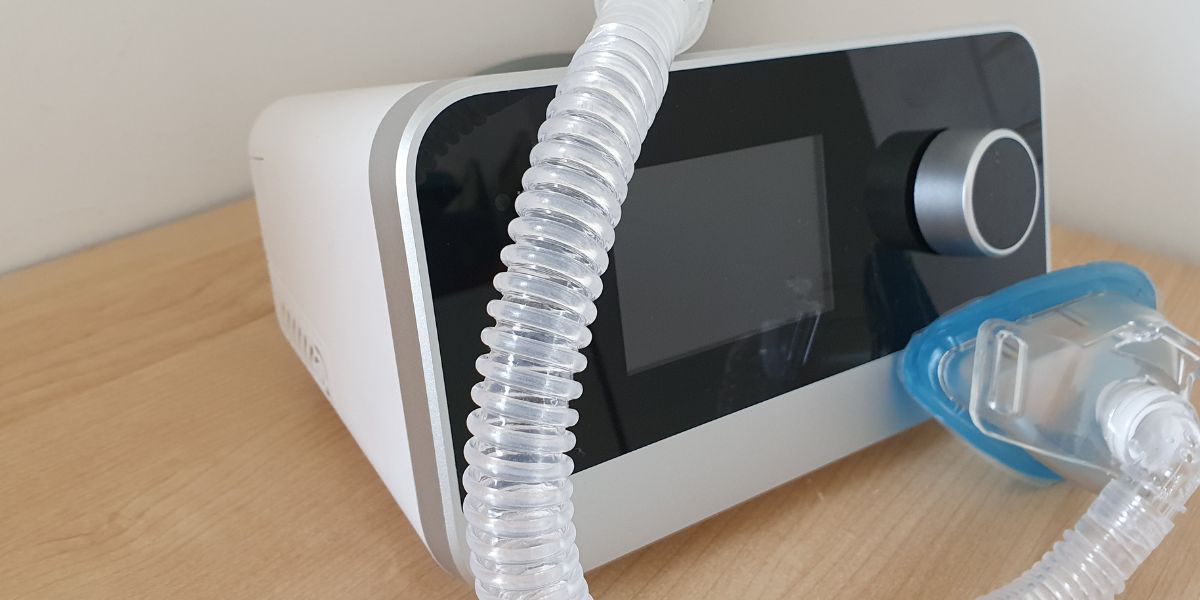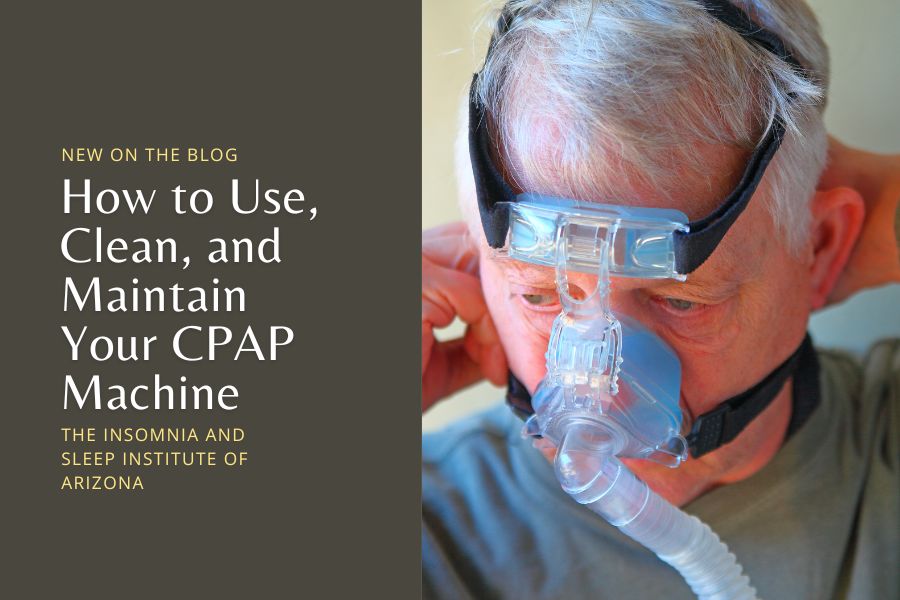Users face issues from improper CPAP care. A well-maintained CPAP can mean the difference between waking up refreshed and feeling drained.
Taking a few minutes each week to clean and check your machine isn’t just routine—it’s essential for uninterrupted sleep. Learn how to set up, clean, and keep your CPAP running smoothly, so you get the most from your therapy, night after night.
What Is CPAP Therapy, and Why Is It the Gold Standard for Sleep Apnea?
CPAP (Continuous Positive Airway Pressure) is the leading non-invasive treatment for obstructive sleep apnea (OSA). It works by delivering steady air pressure through a mask to keep airways open, preventing breath-holding episodes (apneas).
Why CPAP is Essential:
- Proven Results: CPAP reduces apnea events by over 70%, cutting health risks like hypertension, stroke, and heart issues.
- Restores Healthy Sleep: By preventing airway blockages, CPAP allows for restorative, uninterrupted sleep, particularly in crucial REM stages.
- Boosts Daytime Energy: Regular CPAP use often results in greater alertness, energy, and cognitive performance during the day.
Known as the “gold standard” for OSA, CPAP is trusted for its safety, effectiveness, and immediate impact, endorsed by the American Academy of Sleep Medicine (AASM) and top sleep experts.
Correct CPAP Machine Usage
For more details, here’s a full video guide to assist you.
How to use your new CPAP device by The Insomnia and Sleep Institute of Arizona
Starting with a CPAP machine requires careful setup to ensure effective use and comfort. Here’s a step-by-step guide:
1. Power and Placement
Connect the machine directly to a power outlet or surge protector. Avoid extension cords, as they can introduce safety hazards. Ensure the intake area of the machine is clear to allow proper airflow. A blocked intake reduces effectiveness and can increase the machine’s workload.
2. Filter Check
The CPAP machine includes a small, removable air filter located near the intake. Check this filter every two weeks.
If you see dust or discoloration, replace it with a new one (replacement frequency may vary by model. Monthly replacement is often recommended).
3. Water Chamber Setup
Many CPAP machines have a humidifier chamber to prevent dryness. Fill the water chamber to the indicated max line with distilled water only.
Overfilling can lead to water leakage, which may reach the tubing or mask. Clean the chamber weekly with mild soap to prevent bacterial buildup.
4. Tubing Connection
Attach the CPAP tubing securely to the port at the back of the machine. If using heated tubing, align any sensor or power connectors, as these are important for temperature control and maintaining optimal humidity.
5. Mask Fit and Comfort
Give your mask a quick test before bedtime. Adjust the straps until it feels comfortable and snug.
Avoid leaks, as they reduce air pressure and make therapy less effective. For nasal masks or pillows, the mask should sit just over your nose. Full-face masks should cover both your nose and mouth for the best results.
6. Pressure and Ramp Settings
Modern CPAP machines often feature a ramp setting, which starts with lower pressure and gradually increases.
This feature makes it easier to fall asleep without feeling overwhelmed by the airflow. Ramp settings can typically be customized to suit your needs or can be turned off entirely if higher pressure is preferable.
7. Automatic Start and Stop
CPAP machines are equipped with sensors that detect breathing patterns. Once you put on your mask and begin breathing, the machine will automatically start.
Similarly, most devices stop when you remove the mask in the morning. If you prefer manual operation, use the start/stop button as desired.
8. Daily Mask Cushion Cleaning
Clean your mask cushion daily to prevent skin irritation and keep the seal tight. Use a non-alcoholic wipe, baby wipe, or a soft washcloth with mild soap. This simple step removes oils and residue, helping your mask perform at its best.

Keeping Your CPAP Machine Clean and Well-Maintained
For more details, here’s a comprehensive video guide on effective CPAP cleaning and maintenance:
How to Clean and Resupply Your CPAP Machine? by The Insomnia and Sleep Institute of Arizona
Proper CPAP machine cleaning can prevent respiratory issues, improve machine efficiency, and maximize the effectiveness of your treatment.
Below are seven expert-backed tips to help you maintain your CPAP machine and enhance your sleep therapy.
1. Use Distilled Water in the Humidifier
Using distilled water in your CPAP humidifier keeps things clean. Fewer mineral deposits mean less worry about bacteria and mold building up. On the other hand, tap water contains minerals that lead to scaling, which shortens the humidifier’s life.
Distilled water prevents that buildup. It saves your humidifier from wear. With fewer deposits, you’ll also spend less time on deep cleaning. Instead, you can stick to the essentials and enjoy a fresher, more efficient setup.
2. Empty and Clean the Water Chamber Daily
Humidifier chambers are prone to bacteria buildup due to their moist environment. After each night’s use, empty any remaining water to prevent the growth of mold and mildew.
Cleaning the chamber with warm soapy water ensures it stays free from harmful pathogens. Allow the chamber to air dry during the day before the next use. Regular maintenance helps ensure a continuous and safe airflow, reducing the risk of respiratory infections from contaminated air.
3. Disassemble and Clean the Mask Each Morning
Your CPAP mask sits right against your skin, collecting oils, dead skin cells, and other debris that can lead to bacteria buildup. Disassembling and cleaning it every morning helps reduce skin irritation and keeps it hygienic, ensuring a good seal.
Clean the mask parts with warm, soapy water, avoiding alcohol-based cleaners that can damage the materials. Let each part air dry fully before putting it back together.
4. Rinse and Dry Tubing to Maintain Airflow Quality
CPAP tubing carries air from the machine to your mask, making it important to keep it clean and free of blockages. Ideally, rinse your tubing with warm water at least once a week and hang it to air dry. For a more thorough cleaning, consider using mild, non-abrasive soap.
Moisture can create an environment for bacteria and mold, which is why drying thoroughly is essential. Some users find it helpful to hang the tubing in a well-ventilated area to speed up drying and ensure no water remains trapped inside.
5. Avoid Ozone and UV Cleaners for Safety
Though some cleaning devices advertise the use of ozone gas or UV light as convenient CPAP cleaning solutions, these may not be safe or effective. According to the FDA, neither ozone nor UV cleaners are approved for CPAP machines due to potential respiratory issues and skin or eye irritation.
Ozone gas, also marketed as activated oxygen, can leave residuals in the machine, posing a health risk. Sticking to manual cleaning with mild soap and water is both safe and effective, preserving your machine’s warranty in many cases.
6. Replace CPAP Parts Regularly to Prevent Wear
Replacing worn-out components of your CPAP machine is key to maintaining optimal performance. Recommended replacement schedules based on industry standards are:
- Mask Cushion: Every month
- Headgear and Mask Frame: Every three to six months
- Tubing: Every three months
- Air Filter: Every two to four weeks, depending on your environment
Replacing parts regularly keeps your sleep therapy equipment comfortable. Plus, it helps you get the best results possible, night after night.
7. Store CPAP Equipment in a Clean, Dry Area
Where you store your CPAP equipment can affect its longevity. Keep the machine, mask, tubing, and other components in a cool, dry place away from direct sunlight. Exposure to heat or moisture can damage sensitive components, weakening their effectiveness over time.
Choose a designated storage area with minimal dust exposure to reduce the chances of contaminants reaching your equipment. This simple step can go a long way in maintaining a clean, functional CPAP machine and minimizing additional cleaning needs.
These Accessories Can Enhance Your CPAP Experience
CPAP accessories are available to enhance comfort and convenience, making it easier to maintain consistent therapy. Some popular options are:
- Heated Humidifier: Sleep deprivation triggers stress hormones like cortisol, which tend to stay elevated in those with sleep apnea. With CPAP therapy, uninterrupted sleep becomes possible, allowing the body to recalibrate these hormones naturally.
- CPAP Pillow: Regular pillows often mess with mask fit—especially if you’re a side sleeper. A CPAP pillow, though, is different. Its contours are shaped to fit your mask and tubing. This results in a more comfortable position that keeps the seal intact all night.
- Mask Liners: These soft fabric liners fit around the mask’s edges, reducing skin irritation and preventing leaks. Mask liners are particularly helpful for people with sensitive skin or who experience redness from the mask straps.
- Hose Cover: A cover for your CPAP tubing can help prevent condensation from forming inside the tube, which can lead to “rainout” (the buildup of water in the tubing). It also insulates the tubing, making the airflow feel more natural in cooler temperatures.
- Cleaning Devices: Regular cleaning is essential, and CPAP-specific cleaning devices, can disinfect the mask, tubing, and water chamber quickly and effectively. While these devices don’t replace manual cleaning, they are a convenient option for maintaining hygiene.
Each of these accessories can make a significant difference in CPAP comfort and usability, encouraging consistent use and enhancing the overall effectiveness of sleep apnea therapy.
What Happens If a CPAP Is Not Properly Cleaned or Maintained?
Neglecting CPAP maintenance can lead to health and equipment problems that impact the effectiveness of your sleep therapy. Here’s why:
- Bacterial Growth: A CPAP’s warm, moist environment fosters bacteria and mold growth in components like the humidifier and tubing. Inhaling these pathogens can lead to respiratory infections. Sinus issues may also develop. Bad smells are often an early warning sign of bacterial buildup.
- Reduced Air Quality: Dust and debris in CPAP filters and tubing can block airflow, reducing therapy benefits. Unclean equipment may introduce allergens, causing nasal congestion. Skin irritation is also a risk. Respiratory discomfort is common without regular cleaning.
- Shortened Equipment Life: Without regular cleaning, mineral buildup and material wear can quickly damage CPAP parts like the water chamber and tubing. This lack of maintenance often results in costly repairs or replacements.
Where Can You Get Expert Guidance and Ongoing Support for Your CPAP Therapy?
When it comes to expert CPAP guidance and lasting support, The Insomnia and Sleep Institute of Arizona stands out. Expertise leads every step. From initial CPAP setup to personalized adjustments.
Each session, our specialists bring deep knowledge and refined skills. Always driven by a shared commitment to helping you achieve exceptional sleep health.
Your sleep care is backed by our experts. Support that’s more than just medical – it’s personalized, caring, and thorough. Join us! Experience the power of true sleep expertise that transforms nights and fuels vibrant days.
References
American Academy of Sleep Medicine | AASM | Medical Society. (2024, October 22). American Academy of Sleep Medicine – Association for Sleep Clinicians and Researchers. https://aasm.org/
Albertsen, I. E., Bille, J., Piazza, G., Gregory, & Nielsen, P. B. (2024). Cardiovascular Risk in Young Patients Diagnosed With Obstructive Sleep Apnea. Journal of the American Heart Association, 13(8). https://doi.org/10.1161/jaha.123.033506
D’Rozario, A. L., Hoyos, C. M., Wong, K. K. H., Unger, G., Kim, J. W., Vakulin, A., Kao, C.-H., Naismith, S. L., Bartlett, D. J., & Grunstein, R. R. (2022). Improvements in cognitive function and quantitative sleep electroencephalogram in obstructive sleep apnea after six months of continuous positive airway pressure treatment. SLEEP, 45(6). https://doi.org/10.1093/sleep/zsac013
Tregear, S., Reston, J., Schoelles, K., & Phillips, B. (2009). Obstructive Sleep Apnea and Risk of Motor Vehicle Crash: Systematic Review and Meta-Analysis. Journal of Clinical Sleep Medicine : JCSM : Official Publication of the American Academy of Sleep Medicine, 5(6), 573. https://pmc.ncbi.nlm.nih.gov/articles/PMC2792976/
Posadas, T., Oscullo, G., Zaldívar, E., Garcia-Ortega, A., José Daniel Gómez-Olivas, Monteagudo, M., & Martínez-García, M. A. (2020). Treatment with CPAP in Elderly Patients with Obstructive Sleep Apnoea. Journal of Clinical Medicine, 9(2), 546–546. https://doi.org/10.3390/jcm9020546
Office. (2024). Do You Need a Device That Claims to Clean a CPAP Machine? U.S. Food and Drug Administration. https://www.fda.gov/consumers/consumer-updates/do-you-need-device-claims-clean-cpap-machine
Zheng, D., Xu, Y., You, S., Hackett, M. L., Woodman, R. J., Li, Q., Woodward, M., Loffler, K. A., Rodgers, A., Drager, L. F., Lorenzi-Filho, G., Wang, X., Quan, W. W., Tripathi, M., Mediano, O., Ou, Q., Chen, R., Liu, Z., Zhang, X., & Luo, Y. (2019). Effects of continuous positive airway pressure on depression and anxiety symptoms in patients with obstructive sleep apnoea: results from the sleep apnoea cardiovascular Endpoint randomised trial and meta-analysis. EClinicalMedicine, 11, 89–96. https://doi.org/10.1016/j.eclinm.2019.05.012





